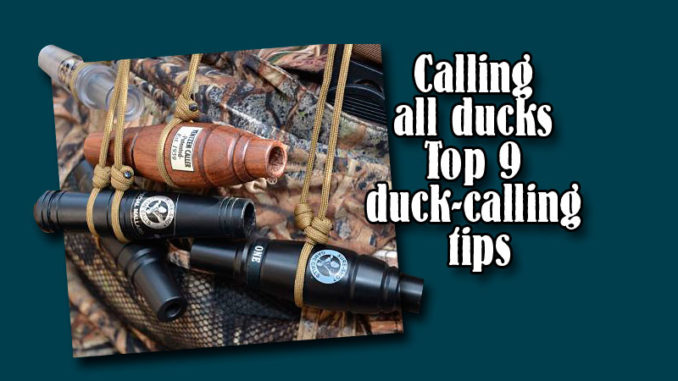
Have you put the time into truly learning how to call ducks into shotgun range? These hunters — who have real duck-hunting chops — tell how to get the most out of your time in the blind.
The cracking light over the Grand Cheniere marsh skies foretold of a good hunt. We could see ducks trading back and forth in the dim light well before legal shooting time.
Lola, the yellow Labrador retriever whined in anticipation of what was to come.
I felt like whining myself. I was in the presence of history.
Sharing the blind with me were Charlie Holder, owner of Sure-Shot Game Calls that produces the legendary Yentzen duck call, and Doug Yentzen, great grandson of George Yentzen who invented the call.
I knew I was in for a duck-calling clinic.
Their duck talk didn’t disappoint. At 6:10 a.m., the pair cajoled a reluctant mottled duck to come in range.
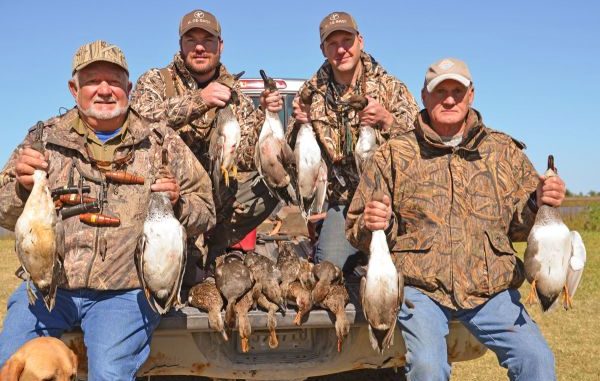
Holder dropped it with one shot.
Then the music began.
Both men called in rather-subdued tones. Even Yentzen’s mallard highballs were seductive rather than demanding.
They pulled off of spoonbill after spoonbill, with Yentzen chuckling that they would probably be sorry later.
They quickly added a couple of teal, two single drake pintails and a pair of gadwalls to their straps.
The other two members of the hunting party, Curtis Arnold and James “Bozie” Holmes, also seemed to be doing well in another blind by the sounds of their shotguns barking.
Holder and Yentzen worked their calls like orchestral instruments, mixing up hail calls with quacks, alluring lonesome hen calls and the occasional feed call. All of this was spiced with liberal doses of pintail whistles, and dusted with teal calls and gadwall grunts.
Arnold and Holmes finished their limits before Holder and Yentzen. We could see their outboard in the distance running through the trainasses scoring the dense marsh grass.
I wanted to get back to the camp, too. But it wasn’t the biscuits that were calling me: The four ace hunters had promised me a couple of hours to interview them and pick their minds about duck calls and calling.
Back at the camp, I learned a little more about our experts.
Holder, at 38, is a young man, although he owns the Groves, Texas, game call company. Already a successful businessman when he bought the firm, he is a former co-host of an outdoors radio show in Texas.
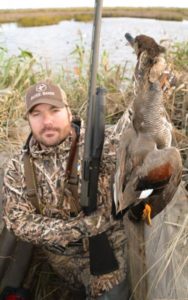
Arnold, is even younger at 35, but he carries a pedigree. His grandfather was James “Cowboy” Fernandez, the man who took George Yentzen’s invention, perfected it and built a powerful company.
Arnold is the production engineer for Sure-Shot and, as a degreed engineer, is an expert on the design and mechanics of duck calls.
Our hunt host, Doug Yentzen, as mentioned above, is George Yentzen’s great grandson. A resident of Lafayette, the 57-year old owner of Coastal Pipe of Louisiana spends huge chunks of each duck season hunting waterfowl.
Yentzen is 57, and has been calling duck for 48 years.
The final member of the group, Bozie Holmes, is an expert caller and crack shot. The Youngsville resident has been hunting 59 of his 64 years.
And this quartet of experts agreed to share their advice on how to become a more effective duck caller. Here are their thoughts.
1. Choose the right call
On average, single-reed calls are higher-pitched and double-reed calls are raspier. Double-reed calls are also more user-friendly because no back-pressure is required, according to Curtis Arnold.
All of our experts agreed that trial and error is the way to choose a call.
“Buy cheap calls of each, and try them,” James “Bozie” Holmes advised.
Buyers also have a choice of materials.
Wooden calls, Holder said, have a softer tone and are best on calm days in flooded timber.
Arnold agreed, noting that it is easier to finish birds off with a wooden call in timber — less echo.
But, he added, wooden calls are more affected by moisture. The type of wood is a big thing, with his choice being walnut because of its density and resistance to warping.
Plastic calls — either injection molded or CNC (computer numerically controlled) milled — are the second option.
The former can be recognized by seams that run the length of the call. CNC calls are denser and heavier.
The denser the material is, explained Arnold, the louder the tone you can get. Because they are louder, they are tricky for close-in work.
Cheap is the No. 1 pro on plastic, Holder said.
Arnold added that some so-called “hybrids” — a combination of wood and plastic pressed together — are also available.
Calls milled from blocks of acrylic are another option. Acrylic calls are about pure volume, Holder said, to get the loudest sound out of the end of the call.
Acrylic calls can hail birds from long distances, but users must be careful on close-in birds, Arnold cautioned. The biggest knocks on acrylic calls are breakage due to their brittleness and their price, said Holder. A duck hunter on a budget is not going down the acrylic road.
2. Seek instruction
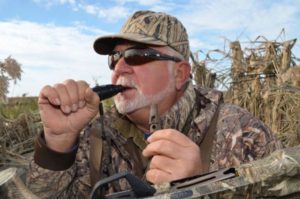
Learning to blow a duck call properly comes faster with instruction. Without instruction, some hunters never learn to blow a call.
Holder, a big computer buff, recommended hunters go to YouTube for demonstrations. Instructional DVDs or CDs also may be purchased from retailers and are very useful, he added.
Arnold suggested a trip to a call maker for those for whom it is possible. Holder nodded in agreement, adding that they don’t solicit visitors — but that they always take time with hunters who drop in.
Holmes, a man who has been around ducks all his life, nodded vigorously in agreement with a suggestion to visit parks and ponds that have a population of domestic ducks to listen to them and practice calling to them.
All four men agreed that the time not to seek instruction was in the hunting blind.
3. Start with the basics
Mastering all the calls that a mallard makes at one time is difficult. Our four experts disagreed wildly about what the most-basic call is.
Holder said the lonesome hen call. Holmes said the feed call. Yentzen, a master of the hail call, naturally said the hail call. Arnold said the quack is the most basic.
After heated and sometimes humorous discussion, they finally agreed that the quack is the easiest to learn, and that beginners should start with that. Most instructional tapes and discs start instruction with the quack, and then moving to the hail and lonesome hen calls — both of which are modified quacks strung together.
All four agreed that it was important for learners not to confuse a chuckling feed call with the cackle that high-flying mallards make.
4. Practice makes perfect
A few gifted or lucky people can pick up a duck call and make it sing almost immediately. But for most people, proficiency requires practice.
Arnold, who grew up in the duck-call business, said it took him two years, practicing every day, to become proficient. He recommended 10 to 15 minutes of practice a day, every day until a person feels confident of his skills.
Holmes confessed that he hangs his duck calls on the mirror of his truck, where they are always handy. He still, after all his years of hunting, blows them as many days as not.
Holder agreed with Holmes: Do it in your car, where no one can hear you.
Holder also counsels that beginners should not ignore hand movement when practicing. That moves the sound around, and is 30 to 50 percent of calling. Yentzen agreed, giving it a good solid 50 percent.
Hand movement is especially important, Yentzen said, when you want to lower call sounds for close-in ducks.
5. Change tactics for close birds
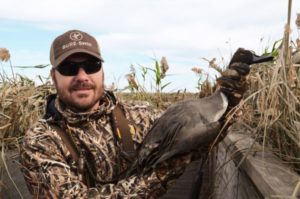
Distant birds are far more forgiving of calling flaws than are birds close to the blind.
Arnold suggested that hunters do less “crazy stuff” and should instead lower their heads and cup the opening of the call.
Yentzen agreed. Do less highballs as the birds close in, especially later in the season.
When birds are skittish, hunters should use pintail whistles, soft quacks and feed calls, he added.
Holder agreed that a pintail whistle is a good finishing call for close but uncommitted birds.
Holmes, a subtle caller, recommended only highballing when birds are going away. When they are coming in, sometimes the best call is no call.
It is most important, Holder added, to ease off and then stop calling when birds are coming dead-on, as well as on birds that are circling and cupping in.
Some highballing is useful for close birds, though — most typically, Holder said, when birds are straight-lining away.
Holmes added that highballing can be effective in making birds that are near lighting out of gunshot range pick up and perhaps circle again.
6. Multiple callers in one blind can be effective
While all skilled duck callers recoil at the thought of sharing calling duties with a poor caller, multiple callers in one blind can be deadly-effective.
But it is critical that everyone has learned to call well, Arnold said.
It is most important, Yentzen added, not to step on the other fellow. Don’t begin a highball in the middle of your buddy’s highball, for example.
Holmes response was succinct: Two callers is enough.
Holder strongly disagreed. He likened having more good callers in a blind to having more decoys. More is better.
Holmes and Yentzen recommended that, when more than one caller is active, it is best to mix whistles, teal calls and mallard calls.
7. Calling tactics should be appropriate to the hunting location
Duck hunting takes place over a range of habitats, including large reservoirs, flooded timber, medium to large marsh lakes and coastal potholes.
For calling, one size definitely does not fit all.
In general, Holder said, there is a need to amplify volume to reach over big water.
Arnold modified Holder’s suggestion for big volume over big water by noting that it is not necessarily the size of the water body that is most important, but rather the distance of the birds.
Yentzen added that factoring in wind direction is very important. If birds are downwind they hear your call much easier. If they are upwind, callers must give more volume to their calls.
But in flooded timber the last thing you want is volume.
Arnold agreed.
Both suggested that in flooded timber there is less need for highballs and more for lonesome hen-type calls.
8. Don’t overdo it
Some people call all the time, the normally good-natured Yentzen grunted.
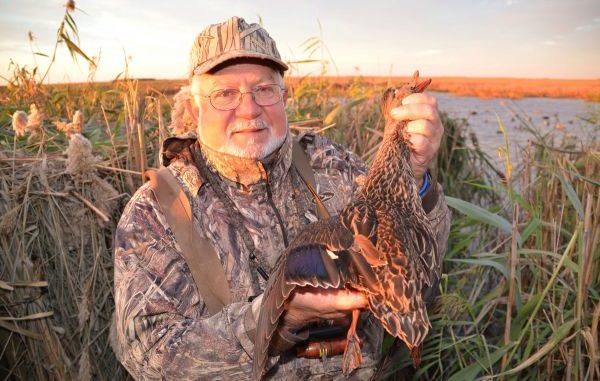
Holmes finished this thought for him — they drive you crazy.
A lot of what they are doing, Holder explained, isn’t sounding like a duck but shouting at the birds.
Calling ducks is about talking to them; listen to them and talk to them.
Overcalling, Holder added, is the first thing that will get you not invited back to a hunt — followed by shooting out of turn.
9. Take care when tuning calls
Arnold, the resident call mechanic, explained that Louisiana-style calls can be made to sound raspier by pulling the reeds up on the trough (toward the end being blown in) or higher-pitched by moving them down the trough.
The reeds on Arkansas-style calls can’t be moved downward because they have no troughs and the reeds butt up against the call bodies.
The reeds on these calls can be made to call a higher pitch by removing them and carefully trimming them with good scissors (not a knife).
Holder quickly added that people can mess reeds up, though. Arnold and Holder cautioned not to pull, torque or — above all — bend the reeds.
Arnold recommended using a nail to push the peg out from the bottom to free the reeds.
Good calling is only part of the pie
Our experts unanimously agreed that, while good calling is important, it is only one component of successful duck hunting.
Hunting the right spot is important: Even the best caller can’t make ducks go where they don’t want to be.
Hiding the hunters is important. Blinds should be well brushed and, if possible, fit into the background.
Hunters must hide themselves, even in well-brushed blinds. Hunter movement will alert birds immediately of the hunters’ presence. Waving gun barrels about the top of the blind, especially on sunny days, is a no-no. Always wear camouflage.
The use of decoys is another part of the game. Crowding them too close to the blind draws the birds’ attention to the hunters’ hide. Placing them too far away induces birds to light out of gun range.
Motion decoys are still a worthwhile investment, especially in the early and middle part of each season.
And, of course, you have to be able to hit them. So learn to shoot.


